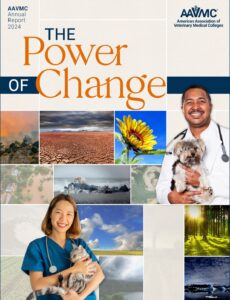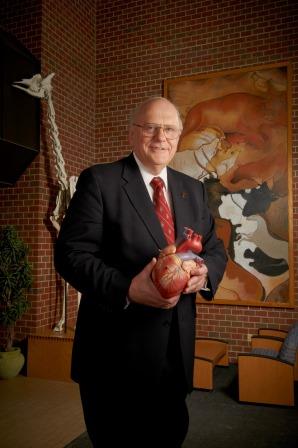MEDIA CONTACTS:
Jeff Douglas or Jeanne Johnson
Phone: 202/371-9195, x144
Email: jdouglas@aavmc.org or jjohnson@aavmc.org
WASHINGTON, D.C., June 28, 2021 — As young person who dreamt of becoming a Doctor of Veterinary Medicine (DVM), Daryl Buss never envisioned himself as the editor of an academic journal. But that role was the capstone of a distinguished career that included clinical practice, teaching, major advancements in cardiovascular research, leadership of academic institutions and the American Association of Veterinary Medical Colleges (AAVMC), and ultimately, Editor in Chief (EIC) of the AAVMC’s Journal of Veterinary Medical Education (JVME).
Dr. Regina Schoenfeld-Tacher from the North Carolina State University College of Veterinary Medicine succeeds Dr. Buss as the JVME EIC effective July 1. But after almost a decade of leadership, Dr. Buss can look back at a tenure that brought steady progress, growth, impact and advancement. Among many achievements, the JVME has become more international in scope and successfully transitioned from a primarily print publication to a hybrid print/digital model with expanded open access.
He sees this as a good time to pass the journal on to a new generation that will negotiate change as he has, always adapting to societal and technological transitions with agility and a commitment to solid scholarship.
Under his tenure, the journal instituted an AAVMC Notes section to “enhance awareness of the AAVMC,” and convey information about AAVMC-related news and events. He oversaw the publication of theme issues on relevant topics such as a 2017 issue on “Mental Health and Well-Being of Students and Graduates of Veterinary Medical Educational Programs” and a 2019 issue on “Inter-Institutional Collaboration in Veterinary Medical Education.”
The journal saw such an increase in the number of submitted manuscripts that it expanded from four to six issues per year to accommodate the need. In addition, the number of downloaded manuscripts doubled from about 20,000 in 2012 to more than 44,000 in 2020.
As EIC, Dr. Buss said that he has particularly enjoyed working with enthusiastic and energetic junior faculty, both in the United States and internationally, who have “given the journal a wider perspective and are open to new ideas.” He credits the journal’s editorial board with being a valuable sounding board. “Even when we had different perspectives, we were able to have good, open discussions and eventually get everyone on the same page.”
Dr. Buss said his career path has been less about planning and more about the emergence of serendipitous opportunities, where momentous career decisions might be made over a cup of coffee. For that reason, despite the practicality of goal setting, he encourages students and young veterinarians to always be open to unexpected opportunities.
“Mentorship programs are great, but students should also be proactive,” he said. That would include identifying respected faculty and those who work in interesting fields and expressing interest. He encourages students to become aware of careers in all facets of veterinary medicine, including academia, government, public health and industry.
Among the many changes that he has seen in academic veterinary medicine throughout his career, he considers an increased emphasis on teaching as a skill set, and academic research supporting that skill, as one of the most positive developments. He started out in private practice but the decision to pursue further education resulted in the discovery that he loved cardiovascular research. That discovery led to a career in academia where, funded by organizations like the National Institutes of Health and the American Heart Association, he made substantial contributions to the body of knowledge in cardiology, authoring or co-authoring 74 publications in academic journals.
He served as professor and chair of the Department of Physiological Sciences at the University of Florida College of Veterinary Medicine, with a joint appointment in the College of Medicine’s Division of Cardiology, and then for 18 years as the dean of the University of Wisconsin School of Veterinary Medicine. He had previously been named Dean Emeritus and Professor Emeritus at Wisconsin when he started serving as JVME’s EIC in 2013.
He has also made lasting contributions to academic veterinary medicine through his long association with the AAVMC, where he served as a member of the Board of Directors and as president in 2000-2001.
He landed at JVME partly as the result of encouragement from others. “I had been a dean for a long time, so I knew all of the deans,” he said. “I’ve always valued critical feedback and I valued their advice and opinions. So even though it wasn’t on my target list, when others suggested the possibility, I was intrigued.”
As usual, he was open to the unexpected. And as has proven to be the case for him and for JVME readers, wise counsel paid off.
ABOUT THE AAVMC
The member institutions of the American Association of Veterinary Medical Colleges (AAVMC) promote and protect the health and wellbeing of people, animals and the environment by advancing the profession of veterinary medicine and preparing new generations of veterinarians to meet the evolving needs of a changing world. Founded in 1966, the AAVMC represents more than 40,000 faculty, staff and students across the global academic veterinary medical community. Our member institutions include veterinary medical colleges and schools in the United States, Canada, Mexico, the Caribbean, the United Kingdom, Europe, Asia, Australia, and New Zealand as well as departments of veterinary science and departments of comparative medicine in the U.S.
Download a photo of Dr. Buss.
– 30 –






SHARE